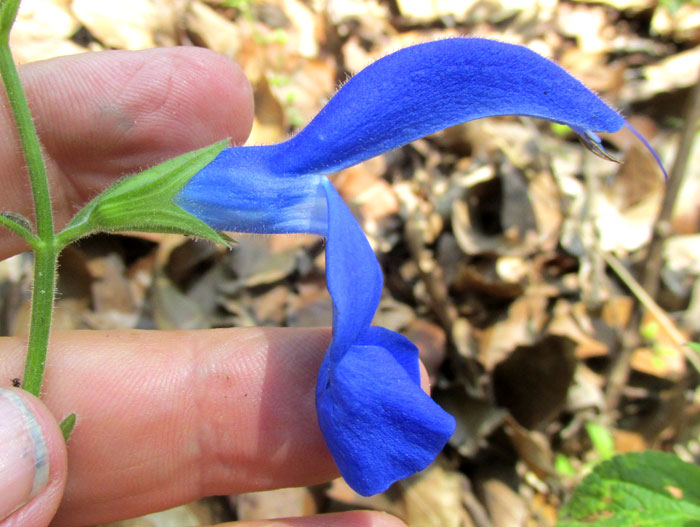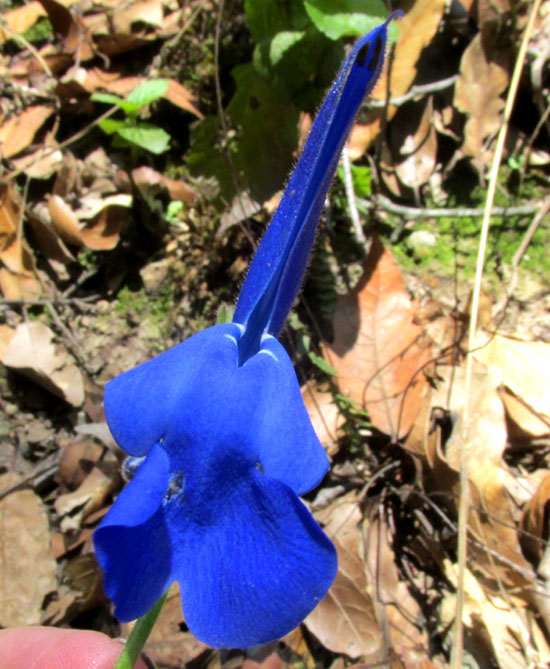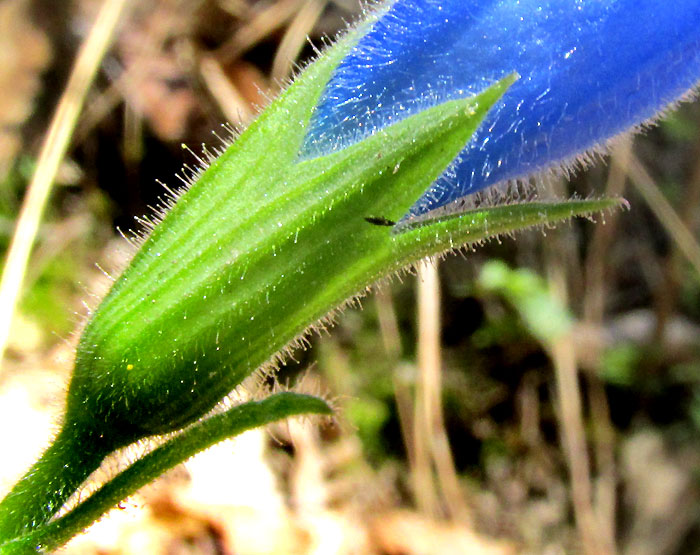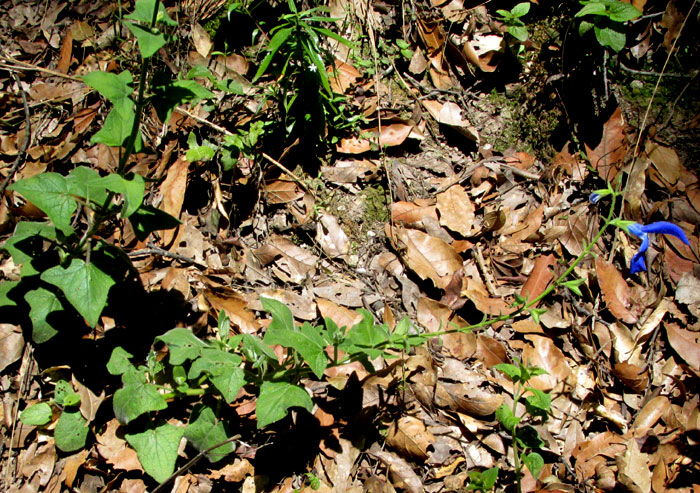Excerpts from Jim Conrad's
Naturalist Newsletter
entry from field notes dated July 2, 2022, taken on Cerro de la Cruz, at an elevation of ~2885m (~9465 ft), just south of the community of El Pinar, Amealco de Bonfil, Querétaro, MÉXICO, (~N20.17°, ~W100.17°)
GENTIAN SAGE

At the mouth of a valley opening toward the east and mantled with oak forest, in the rich soil of a dry arroyo's bed between Cerro de la Cruz and an adjacent peak, a patch of sunlight on the otherwise shadowy forest floor spotlighted the above flower. There, where wind and sunlight didn't much penetrate, amid the somberness this splash of sky blue was unexpected and dazzling. I'd never seen such a large, naturally occurring salvia blossom. It was obviously a salvia, because of the flower's distinctive structure.

The corolla's large lip -- the pollinator landing pad -- flared widely, but at the back, where white nectar guides ushered visitors toward the nectar, there was a tight constriction. The corolla's upper part was unusually flattened. Still, in the picture you can see the two blackish anthers at the very top of the corolla's opening, exactly where salvia anthers belong.
Salvia stamens are famous for their pollinating mechanism. The filaments of each of a flower's two stamens is equipped with a kind of lever positioned so that when the pollinator enters the corolla tube, the pollinator pushes against the lever, causing the anthers at the corolla's top to swivel down and daub the pollinator's rear end with pollen. With such evolutionary consideration given to salvia stamens, despite the corolla's top seeming strangely narrow to me, it's certain that this species "has it all figured out."
Salvias comprise a big genus, the genus Salvia, which currently comprises about 900 species. Botanists shy away from publishing comprehensive analyses of Salvia species because genetic sequencing indicates that our traditional notion of what a salvia is, is faulty, and it'll be a very big job figuring it all out. Therefore, expecting trouble identifying this species, close attention was given to details.

The calyx seen above looked typical for the salvias, except for its large size, which really wasn't disproportional for such a big corolla. The dense covering of stickily gland-tipped, erect, and very slender hairs was noteworthy. More distinctive were the leaves:

The leaves were broad and hairy, on fairly long petioles. Their most distinctive feature, though, was that each of the larger blades bore at their bases flaring, pointed lobes. In botany, such leaves are said to be "hastate." Also, notice that the stem is lying on the ground. The plant had erect stems, but also others that spread horizontally.
Below, you can see that while the stem holding our flower spreads close to the ground, while another stem stands erect.

There being no treatment of the central Mexican highland's salvias, the best I could do was to see which Salvia species are listed in the 2020 Guanajuato state government inventory of plant species found in the state, entitled "Documento Técnico Base del Inventario de Especies Vegetales Nativas del Estado de Guanajuato. Guanajuato is the state on Querétaro's northwestern border. The inventory listed 42 Salvia species, and on the Internet I compared the pictures of each with our plant. Our plant was distinctive enough to clearly announce itself as Gentian Sage, SALVIA PATENS.
Salvia patens bears an English name because I'm not the first to be bedazzled by the plant's blossoms. Though the species is endemic just to the uplands of central Mexico, as early as 1838 it was introduced into horticulture, in Europe. Today various cultivars are sold, including: 'Blue Angel,' known as "one of the smallest of the full-sized varieties"; 'Dot's Delight,' with corollas bicolored white and blue; and 'Guanajuato Seed Strain,' with the largest flowers.
On and on the pages go selling variations on this species, but it's hard to find information about the wild plants in their native habitats.
So here we offer some: The species looked happy rising from a deep carpet of oak leaves covering rich soil on the floor of a mountain arroyo. The oak woods was shadowy and cool, at around ~2885m (~9465 ft) in elevation. And when the Sun lit it up our plant's single flower, the whole valley seemed to sing with it.